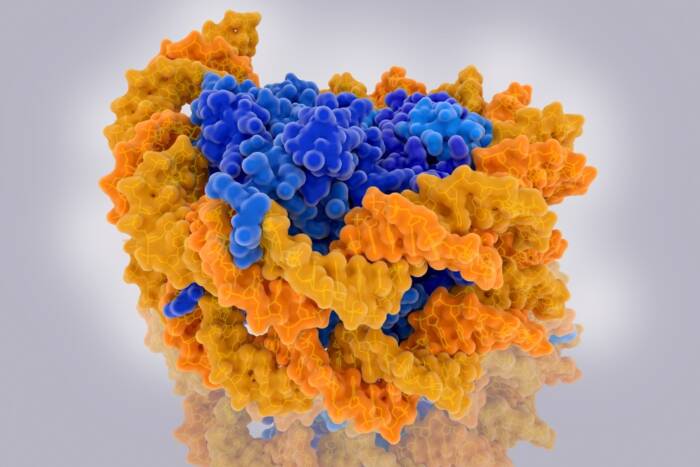Following in family’s footsteps, Alicia Darnell wins national science prize
by TALLEY HENNING BROWN

Family tradition. Alicia Darnell having tea with her family (from left, Jennifer, Bob and Jim) in Paul Nurse’s office in December.
For Alicia Darnell, science fairs are serious business. After two summers spent in research laboratories, the high school senior took home more than just extra credit — Ms. Darnell is this year’s second-place winner in the national Siemens Competition in Math, Science and Technology. The daughter of Associate Research Professor Jennifer Darnell and Professor Robert Darnell and the granddaughter of Professor Emeritus James Darnell Jr., Ms. Darnell — herself a former Science Outreach student — represents the third generation of Rockefeller University scientists in her family. Her project, titled “Alternative Splicing Defects Linked to Amyotrophic Lateral Sclerosis (ALS),” garnered her a $50,000 scholarship. The award was announced December 3 at New York University.
In recognition of her accomplishment, Rockefeller President Paul Nurse named Ms. Darnell “Professor for a Day” and invited the Darnell family to tea in the President’s Office following the Holiday Lectures on Science on December 27. “Alicia’s achievement, at the age of 17, is an especially remarkable credit to an already remarkable family,” Dr. Nurse says.
Ms. Darnell’s scientific roots run deep on both sides of her family tree. Alongside the paterfamilias, her maternal grandfather, Eugene Cordes, is a chemist who has worked in both academia and the pharmaceutical industry, and her maternal grandmother, Shirley Cordes, is a Ph.D. biologist. “My family didn’t try to push me into science, but I’ve had a lifelong immersion in it, so my interest in research came very naturally,” Ms. Darnell says. Her interests don’t end in the laboratory, however; she is a member of the varsity lacrosse team at Pelham Memorial High School, where she’s a senior editor of the student newspaper.
The idea for Ms. Darnell’s winning project came during her stint as a Rockefeller Science Outreach student. She spent her first summer with the program, 2006, in A. James Hudspeth’s laboratory, modeling the external auditory organ of the zebrafish in vitro. “That model is very similar, mechanistically, to stem cells, and my interest in stem cells meshed with my interest in disease therapeutics during that summer,” she says. The following year, she was the first Outreach student to conduct her project collaboratively, spending part of the summer in her father’s lab and part in the laboratory of Tom Maniatis at Harvard University. Her research at Harvard focused on identifying alternative mRNA splicing defects that might play a causative role in ALS, or Lou Gehrig’s disease. “I was so excited to get my first results in the Maniatis lab that I knew I had to enter the research in the Siemens Competition,” she says.
Considered one of the most prestigious high school competitions in the country, the Siemens Competition was established in 1998 by the Siemens Foundation, which provides over $2 million a year in scholarships to students and teachers in the fields of math and science. It’s a grueling contest. Entrants from across the country — this year there were over 1,600 team and individual projects — are winnowed down to a maximum of 300 on the basis of research abstracts they send to a panel of judges chosen by the College Board and the Educational Testing Service. At the semifinal contests, which are held at colleges across the country in October, up to five individuals and five teams are chosen for each of six regions. The winners of the regional contests in November — one individual and one team for each region — each receive a $3,000 scholarship, a silver medal and a slot in the nationals. (The regional winners’ schools each receive $2,000 to go toward science and math education.)
At the national contest, this year held at New York University in December, students compete for a top prize of $100,000. “First you give a 12-minute presentation of your work, before a dozen judges, and then you get a 12-minute session to defend your research, kind of like a mini-dissertation, where those 12 judges all get to ask questions,” Ms. Darnell explains. “I had no idea what to expect from them; there were too many of them for me to be able to tell how I was doing. When they called my name for second place, it was absolutely surreal.”
Having cleared that hurdle with flying colors, Ms. Darnell now has the task of choosing a college, a question she says is still firmly up in the air. “I know I want to somehow combine scientific research, specifically in medicine and epidemiology, with journalism,” she says. “So I’m looking for programs that will help me do that.”
“It’s so good to see someone with Alicia’s intelligence go into science, which really needs young minds,” says James Darnell. “And aside from her success in the laboratory, we are very proud of Alicia’s composure and her speaking ability, which are so important. She can get through an entire presentation without saying ‘like’ a single time.”


